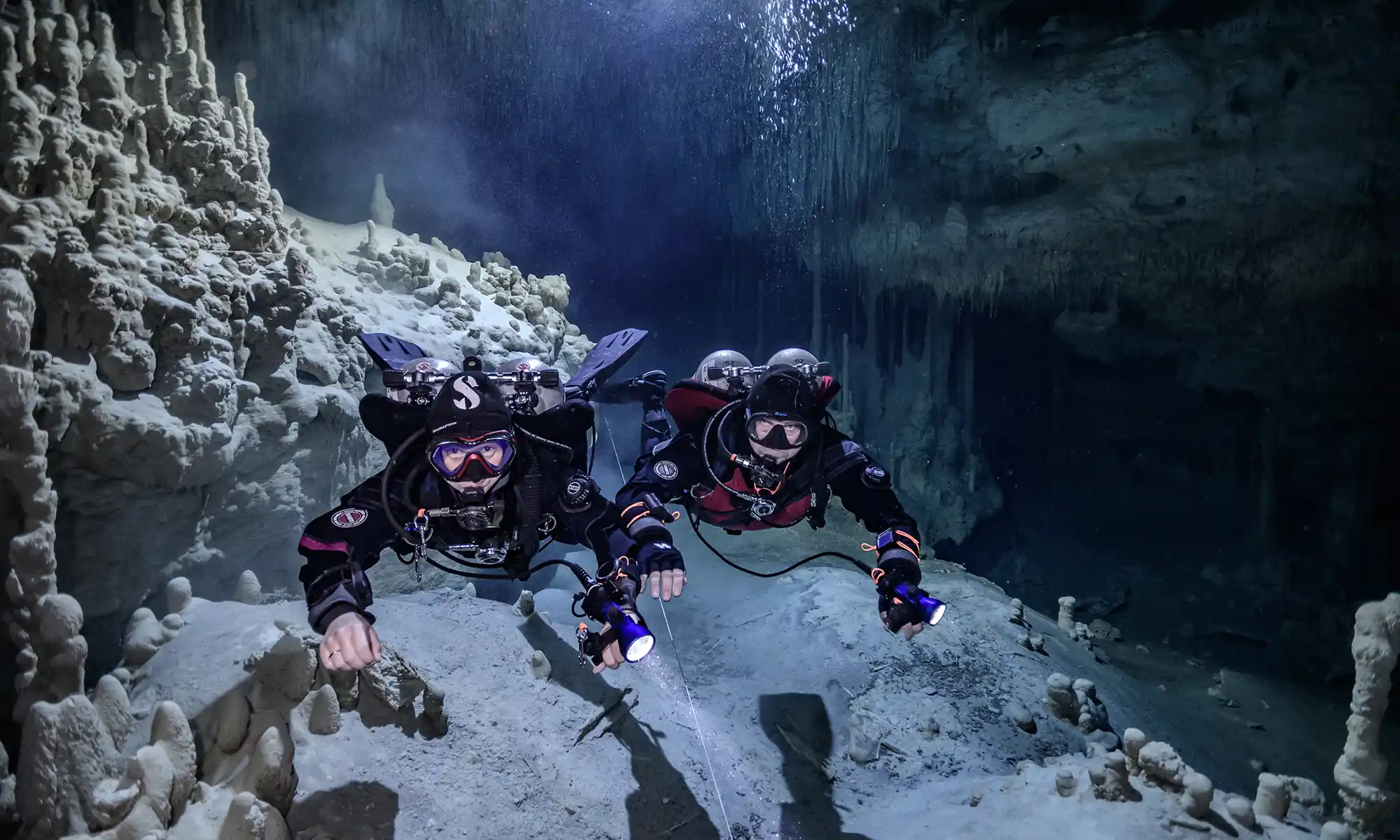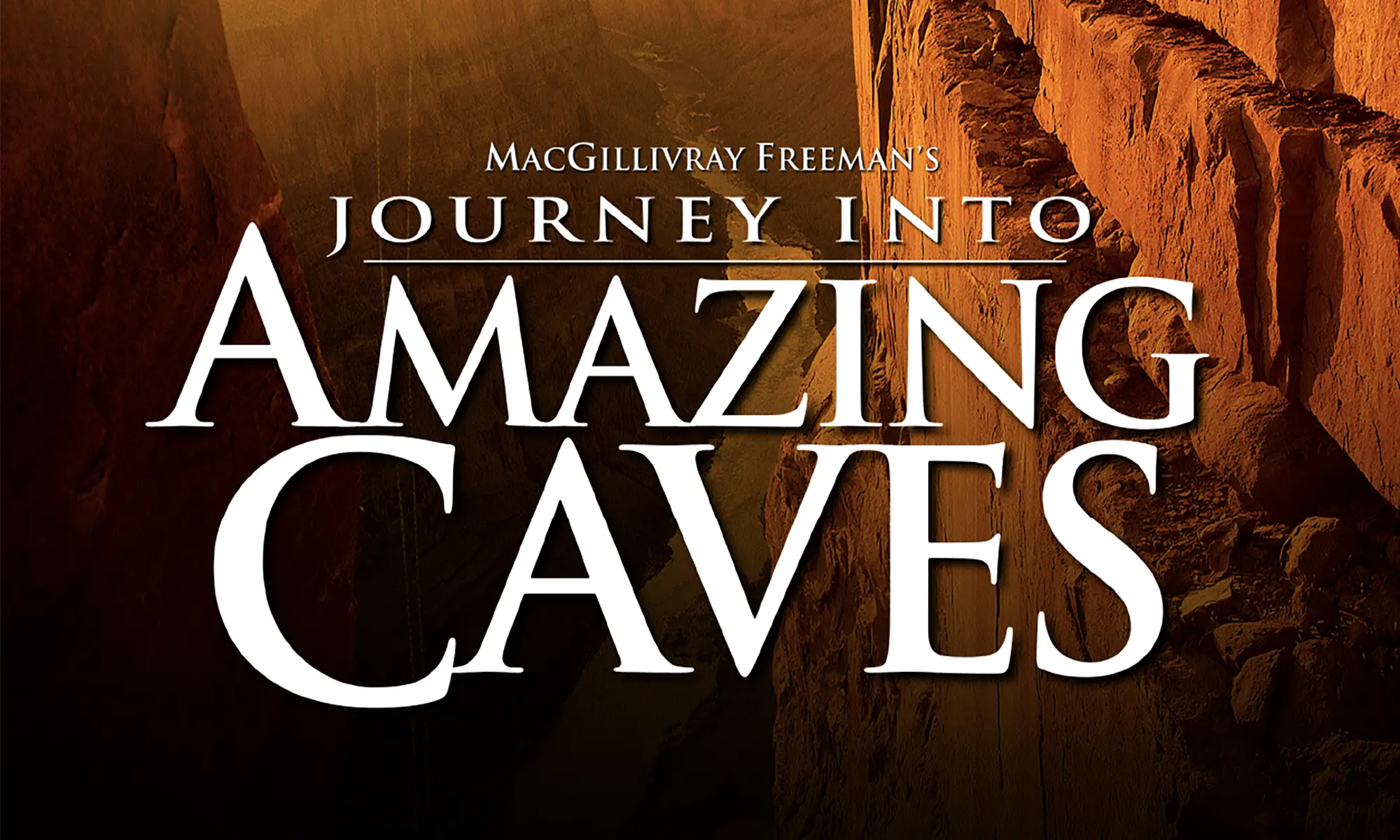Here are the most well-known cave diving movies for your reference. Enjoy the list of Documentary and Feature Films related to cave diving.
Unfortunately, only the documentaries on our list show cave diving in any truthful way.
As for feature films, for the moment, Sanctum (2011) is probably the only more or less adequate one about cave diving yet. I suppose this became possible because the film was produced by diving enthusiast James Cameron and is based on a true story set in 1989 at the Nullabor Cave in Australia.
Natural World (1983)
 Documentary
Documentary
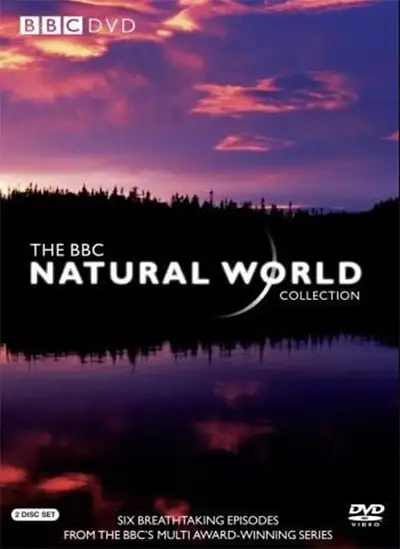
Natural World is a strand of British wildlife documentary programs broadcast on BBC Two and BBC Two HD and regarded by the BBC as its flagship natural history series.[1] It is the longest-running documentary in its genre on British television, with nearly 500 episodes broadcast since its inception in 1983.[3] Natural World programs are typically one-off films that take an in-depth look at particular natural history events, stories, or subjects from around the globe.
Natural World was produced by the BBC Natural History Unit in Bristol under the stewardship of the series editor, who was responsible for commissioning or acquiring content. Programs are a mixture of in-house productions, collaborative productions with other broadcasters, or acquisitions from independent producers. There were 10 programs broadcast each year, of which approximately half were produced in-house.[4] The series is closely tied to the US series Nature, which was broadcast by PBS.[2]
The last episode was broadcast on 20 March 2020; no new upcoming episodes are currently listed.[5]
Season 23 Episode 11 Secrets of the Maya Underworld

The short cave diving movie “Secrets of the Maya Underworld” is available on YouTube.
Nullarbor Dreaming (1989)
 Documentary
Documentary
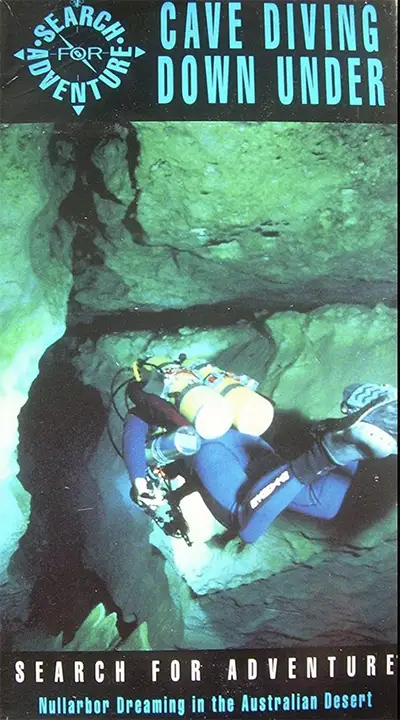
Original real-life footage of the Australian Nullabor cave dive and freak cyclone that dumps 6′ of rain in 25 minutes and traps 15 cave divers underground. It was filled by a master diver in the actual cave-in. This story inspired James Cameron to film “Sanctum (2011)“.
Nullarbor Dreaming is available on YouTube.
Journey Into Amazing Caves (2001)
 Documentary
Documentary
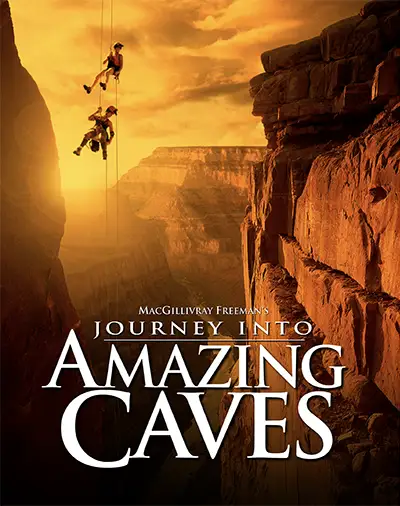
Journey into Amazing Caves is a visceral, suspenseful expedition with a new breed of scientists who boldly explore places once thought off-limits to human presence, let alone IMAX cameras. Join Dr. Hazel Barton and Nancy Aulenbach as they travel to unique and forbidding ice caves in Greenland, underwater caves in the Yucatan, terrestrial caves in the Grand Canyon, and other spectacular locations. You will wriggle through tiny, twisting passages, swim through flooded underground vaults, drop into gleaming blue labyrinths of ice, and enter a world so extreme the microscopic creatures who live there are called extremophiles. For those compelled to push their limits in the world’s most hostile environments, the risk of fatal danger and the thrill of discovery are the everyday factors that make cave exploration such an awe-inspiring experience.
The underwater cave part of this amazing cave diving movie was filmed in the Dos Ojos cave system on the IMAX cave line, which starts from Taak Bi Ha cenote (to be precise, from Dos Ojos Barbie line) and goes up to the Tikim Chi cenote T-intersection.
Narrated by Liam Neeson and featuring a soundtrack with songs and music from The Moody Blues. Journey into Amazing Caves is MacGillivary Freeman Films’ third great adventure film. Photographed with IMAX cameras.
The Cave (2005)
 Adventure, Sci-Fi, Horror
Adventure, Sci-Fi, Horror
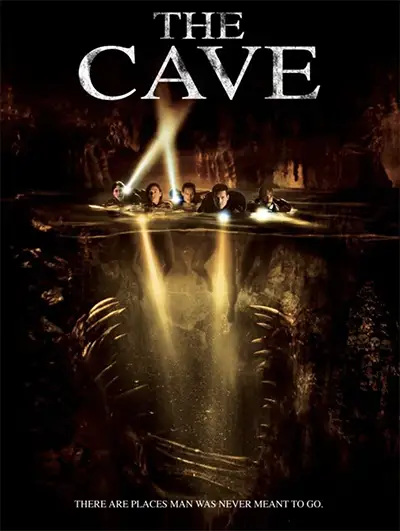
The Cave is a 2005 American action horror film directed by Bruce Hunt. It stars Cole Hauser, Eddie Cibrian, Morris Chestnut, Marcel Iures, Lena Headey, Rick Ravanello, Piper Perabo, and Daniel Dae Kim. Decades after, a rock church in communist Romania’s Carpathians caved when an expedition caused a landslide and buried everyone. Dr. Nicolai’s scientific team, exploring the associated Templar Knights monster fighting legend, discovers a deep, flooded cave system and hires the brothers Jack and Tyler’s brilliant cave diving team to explore it. Another explosion traps them after finding a mysterious parasite, turning all species carnivore, and later an independently evolved predator species. Jack may be infected and turning, but Tyler sticks with him, so the group splits, hunted by the monsters, which also fly.
Written by KGF Vissers. Underwater Unit Director, Wes Skiles.
Planet Earth (2006)
 Documentary
Documentary
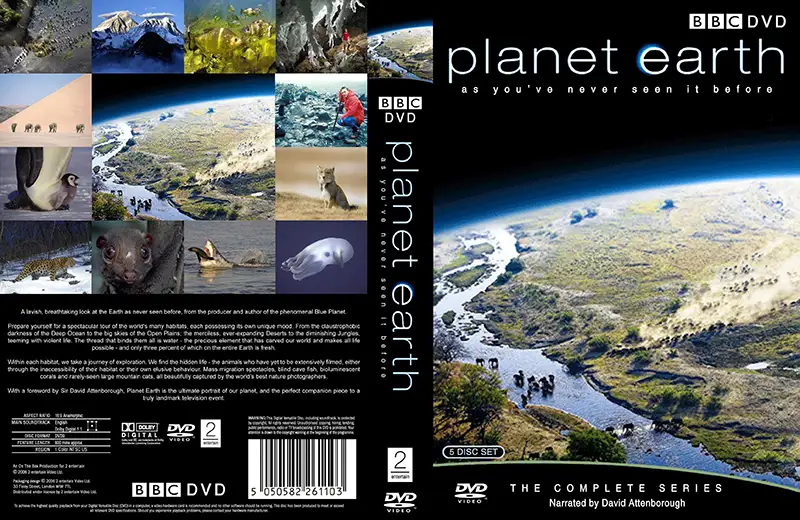
Planet Earth is a 2006 British television series produced by the BBC Natural History Unit. Five years in the making, it was the most expensive nature documentary series ever commissioned by the BBC and the first to be filmed in high definition. Planet Earth premiered on 5 March 2006 in the United Kingdom on BBC One. It had been shown in 130 countries worldwide by June 2007. Its first broadcast in the United States was on 25 March 2007 on the Discovery Channel, with Sigourney Weaver replacing David Attenborough’s original commentary. The series comprises eleven episodes, each featuring a global overview of a different biome or habitat on Earth. At the end of each fifty-minute episode, a ten-minute featurette takes a behind-the-scenes look at the challenges of filming the series.
Episode 4 Caves

Caves’ UK broadcast 26 March 2006, 8.98 million viewers (33 percent audience share); US broadcast 22 April 2007. This episode explores “planet Earth’s final frontier”: caves. At a depth of 400 m (1,300 ft), Mexico’s Cave of Swallows is Earth’s deepest Pit Cave freefall drop, allowing entry by BASE jumpers. Its volume could contain New York City’s Empire State Building. In this episode, divers explore the otherworldly cenotes of the Yucatán Peninsula, appearing to be flying in water (because it is so clear), allowing viewers a glimpse of the hundreds of kilometers of caves that have already been mapped. Cave Divers were Steve Bogearts and Sam Meacham.
Borneo’s Deer Cave and Gomantong Cave are also featured. Inhabitants of the former include three million wrinkle-lipped free-tailed bats, which have deposited guano onto an enormous mound. In Gomantong Cave, guano is many meters high and is blanketed with hundreds of thousands of cockroaches and other invertebrates. Also depicted are eyeless, subterranean creatures, such as the Texas blind salamander and (bizarrely) a species of crab. Carlsbad Caverns National Park is featured with its calcite formations. Mexico’s Cueva de Villa Luz is also featured, with its flowing stream of sulphuric acid and snottite formations made of living bacteria. A fish species, the shortfin molly, has adapted to this habitat.
The program ends in New Mexico’s Lechuguilla Cave (discovered in 1986), where sulphuric acid has produced unusually ornate gypsum crystal formations. Planet Earth Diaries reveals how a camera team spent a month among the cockroaches on the guano mound in Gomantong Cave and describes the logistics required to photograph Lechuguilla. Permission for the latter took two years, and local authorities are unlikely to allow another visit.
Sanctum (2011)
 Action, Adventure, Drama
Action, Adventure, Drama
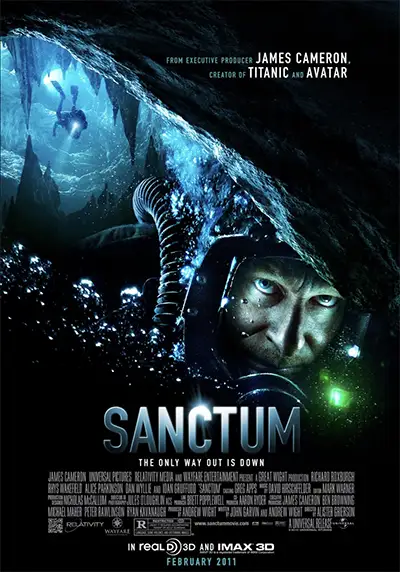
The 3D action-thriller Sanctum follows a team of underwater cave divers on a treacherous expedition to the largest, most beautiful, and least accessible cave system on Earth. When a tropical storm forces them deep into the caverns, they must fight raging water, deadly terrain, and creeping panic as they search for an unknown escape route to the sea. Master diver Frank McGuire has explored the South Pacific’s Esa-ala Caves for months. But when his exit is cut off in a flash flood, Frank’s team-including 17-year-old son Josh and financier Carl Hurley, are forced to alter plans radically. With dwindling supplies, the crew must navigate an underwater labyrinth to make it out. Soon, they are confronted with the unavoidable question: Can they survive, or will they be trapped forever?
Real story
In 1988, Andrew Wight and 21 others were conducting their final explorations of one of Australia’s longest underwater cave systems in the Nullarbor Plain. On the final day of the expedition, a cyclone of unprecedented strength from the sea caused a flood that filled the cave exit and trapped 15 people. The next two days were the most intense and long in their lives. Risking being trapped by unstable rock, they moved meter by meter into the depths to find a new exit to the surface. Fortunately for them, everything ended well, and none of the cave divers remained in those caves forever.
Two documentaries, Nullarbor Dreaming (1989) and Sanctum: The Real Story (2011), tell the real story of Andrew Wight’s team exploration.
23 years later, thanks to Wight’s acquaintance with James Cameron, a feature adaptation of the above-mentioned events was released on the world’s theater screens. To accommodate the not-so-big budget and cinematic requirements, the film’s action was moved to South America, and the number of key event participants was reduced to 6 people. The 3D format was also included.
Sanctum: The Real Story (2011)
 Documentary
Documentary

‘Sanctum: The Real Story’ explores the back story of producer/writer and expedition leader Andrew Wight, who teams up with Hollywood director James Cameron to make a 3-D feature film of a cave diving expedition.
Hidden Worlds: Caves of the Dead (2013)
 Documentary
Documentary
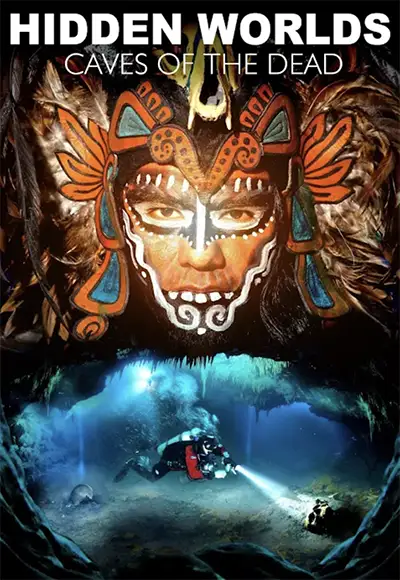
In the days of the Mayas, cenotes – deep, natural pits on the Yucatan peninsula – provided the only means of obtaining drinking water. However, in the mythology of this advanced civilization, these waterholes and caves were also the entrance to Xibalba – the underworld.
In the days of the Mayas, cenotes – deep, natural pits on the Yucatan peninsula – provided the only means of obtaining drinking water. However, in the mythology of this advanced civilization, these waterholes and caves were also the entrance to Xibalba – the underworld. All deceased were obliged to pass through Xibalba and wait until they were called into heaven. It was where one sacrificed to the gods – objects of daily life and bloody human sacrifices. The relics of these acts are still in place and have been preserved underwater for more than a thousand years.
The entrance to the underworld begins at a dirty waterhole in the middle of the Mexican jungle, overgrown and barely recognizable. But a hall of breathtaking dimensions and beauty is revealed immediately after entry. As if they were sculptures, stalactites, and stalagmites lend the underwater cave an almost sacred ambiance. By now, one has succumbed to the fascination emanated by the world’s largest underwater cave system.
We accompany four professional research divers to Yucatan – a team of specialists who can squeeze their bodies through crevices and holes barely larger than their bodies and master dives that would push even the most experienced divers to their limits. You penetrate worlds only a few people have ever ventured into with them. Viewers encounter the remains of human victims, prehistoric fireplaces, and primeval animal skeletons and undertake a dive, which takes us from the primeval forest to the open sea.
We then enter Xibalba – the place of myths and the dead. In the days of the Mayas – a voyage of no return. Today, this is one of the greatest challenges one can face as a diver – the hidden world of the underwater caves of Yucatan – all filmed in 3D.
Diving Into the Unknown (2016)
 Documentary
Documentary
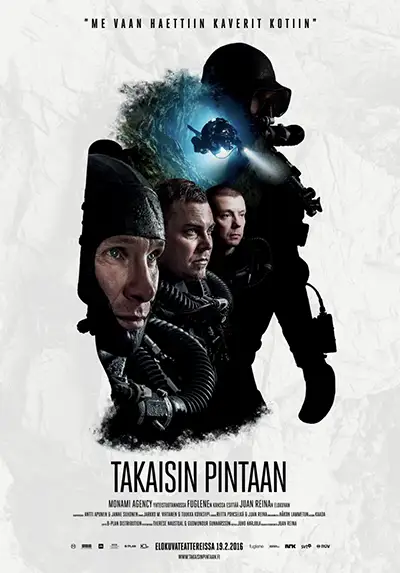
Four Finnish cave divers face their worst nightmare when two of their friends drown deep inside an underwater cave in Norway. When the official recovery operation is called off by the Norwegian and British authorities after being deemed too risky, the friends set out on a secret mission to retrieve the bodies themselves.
Diving into the Unknown isn’t just the dramatic story of a life-threatening mission. It is also a story about unconditional friendship that truly runs deep. While each team member has years of experience exploring dangerous deep-sea caves, as a team, they are about to face the biggest challenge of their lives. To make it out alive, they must be able to rely on each other every second of the way. The physical demands of this operation will pale compared to the psychological toll it will take on everyone involved.
With footage from the real cave accident and multiple cameras above water and deep below the surface, this film follows the breathtaking recovery mission from beginning to end.
On 6 February 2014, a terrible accident happens at 130 m. below the surface in a deep underwater cave in Plurdalen, Norway. Two divers drown, and three miraculously survive. The first victim became entangled in an equipment cord and drowned while trying to change the breathing apparatus (probably switch to bailout? – comment from article author). Police believe the second victim panicked when he came upon the scene several dozen minutes after the first tragedy.
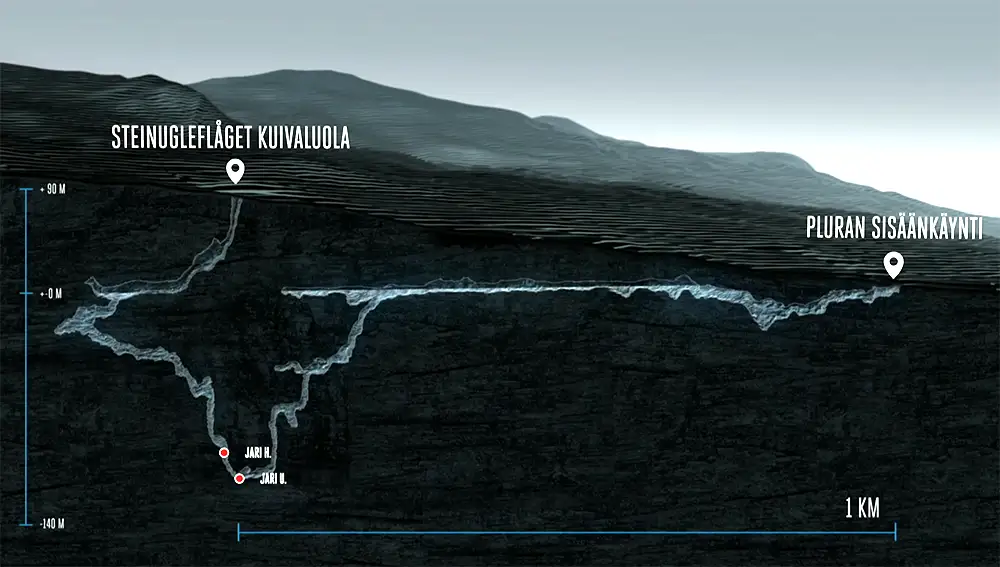
The Plura cave system is located in northern Norway, approximately 50 km from Mo i Rana. It has two entrances: the Plura lakeside and the Steinugleflåget dry cave. The cave system is approximately 2 km long and 130 m deep, with large sharp rocks and extremely narrow passages. The water in the cave is ice-cold, between 2 and 4 degrees Celsius.
The official mission to retrieve the bodies is aborted after being deemed too dangerous by the Norwegian and British authorities. The Norwegian police close the entrance to the cave indefinitely. Determined to bring the bodies of their friends home, the three survivors, Patrik, Kai, and Vesa, with the help of another diver, Sami, put together their team and begin planning a secret recovery mission.
The team consists of 14 Finns and 11 Norwegians, and each team member has an important role. The Finnish team mainly includes people who knew the victims. To avoid being discovered by the authorities, the team splits and makes the 1000 km journey from Finland to Norway at different times.
British diver Rick Stanton, who had been on the first aborted recovery mission, told the BBC that he admires the recovery attempt but remains troubled by the event. He said that with proper training and planning, accidents like this should never happen to experienced divers. “This incident happened, and then they’ve made a film, and they all come out as heroes,” he says. “But these two people should never have died in the first place.”
Partially excerpted from the official movie website DIVING INTO THE UNKNOWN.
The cave diving accident in Plura cave Norway preliminary report on scubaboard.com.
Cave (2016)
 Adventure, Crime, Thriller
Adventure, Crime, Thriller
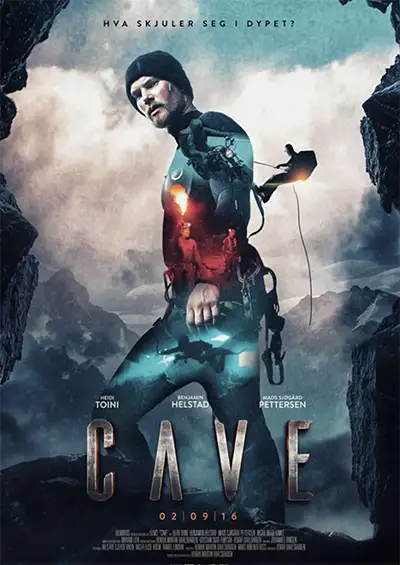
Charlotte, Adrian, and Victor once served together in the same battalion. Therefore, they are used to overcoming difficulties and defying danger. Of the three, only Victor remains in the army. But they come together again to overcome a new obstacle – an unexplored cave system. Several years ago, two Finnish divers died there. The body of one of them was never found. After this tragic incident, the cave was closed. However, the three best friends do not pay attention to this. They want to explore the cave and find an exit on the mountain’s opposite side. They aim to be the first to do this and get out alive. It would seem that they have foreseen everything. Also, they have relationship issues – Charlotte is with Adrian, but she and Viktor used to be a couple, and he still has feelings for her – this complicates the expedition, and someone seems to be following them, even in the cave.
No matter how controversial the film’s plot may seem, the director of the film,
Henrik Martin Dahlsbakken did his best to make the film better. Which naturally affects the film’s excellent audio visualization. The picture is shot very stylishly and beautifully. Like a long video clip. Especially with composer Johannes Ringen’s atmospheric soundtrack and Merete Soltvedt’s vocals, who effectively ends the film with her piercing voice and performance of the song Neverafter.
The atmosphere of mystery and hidden tension is also built quite well on the screen, which intrigues the viewer. Even if it does not consolidate the achievements with a reasonable turn of suspense and a decent spectacle in quantity and staging, the absence affected the overall impression of what was seen.
Curse of the Mayans / Xibalba (2017)
 Action, Drama, Horror
Action, Drama, Horror
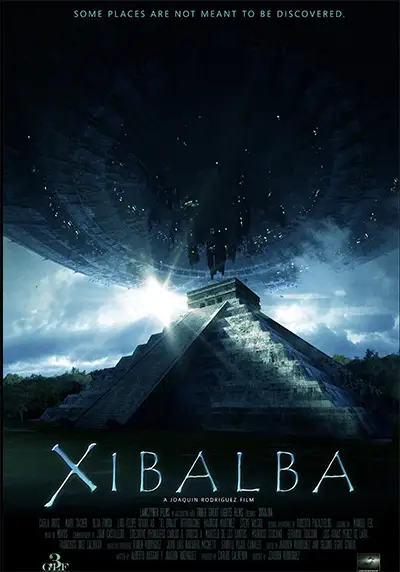
Led by ambitious American Archaeologist Danielle Noble, a team of expert cave divers embarks on an expedition to find the lost Mayan Hall of Records. Little do they know that instead of finding glory, they will find hell hidden in the underwater caves of Xibalbá.
It’s a bit far from real cave diving, plus a very, very low budget.
Это все таки не совсем фильм о пещерном дайвинге так как показанное достаточно далеко от реального пещерного дайвинга, плюс фильм имеет весьма ограниченный бюджет.
National Geographic/PBS Nova – Searching for a Skull (2018)
Documentary

Watch as a team of cave divers recover an ancient Naia skull – the name given to a 12,000 – to 13,000-year-old human skeleton of a teenage female found in the Yucatán Peninsula, Mexico. Her bones were part of a 2007 discovery of a cache of animal bones in a cenote called Hoyo Negro (Spanish for “Black Hole”). At the time of Naia’s death, the cave system was mostly dry, and she likely died falling into Hoyo Negro.
The remains are the “oldest, most complete and genetically intact human skeleton in the New World.”
Hoyo Negro Cave is located in Sac Actun – Nohoch – Dos Ojos – the second largest underwater cave system in the world, located in the Yucatan Peninsula, Mexico.
47 Meters Down: Uncaged (2019)
 Adventure, Drama, Horror
Adventure, Drama, Horror
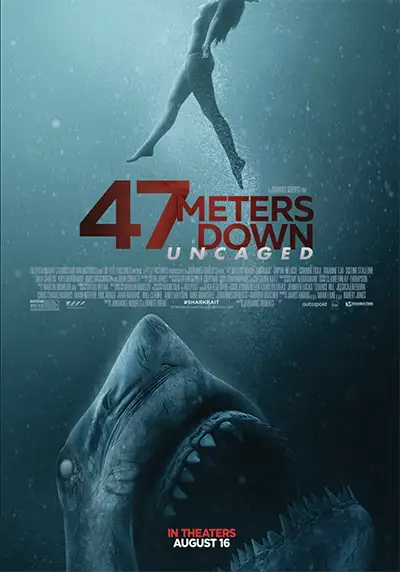
47 Meters Down: Uncaged follows the diving adventure of four teenage girls (Sophie Nélisse, Corinne Foxx, Brianne Tju, and Sistine Stallone) exploring a submerged Mayan City. Once inside, their rush of excitement turns into a jolt of terror as they discover the sunken ruins are a hunting ground for deadly Great White Sharks. With their air supply steadily dwindling, the friends must navigate the labyrinth of claustrophobic caves and eerie tunnels to find a way out of their watery hell.
Unfortunately, the film crew forgot, didn’t want, or didn’t have the budget to hire diving consultants. So, in terms of diving, especially cave diving, this film is complete nonsense. But you can watch it once with a beer.
Dave Not Coming Back (2020)
 Documentary
Documentary
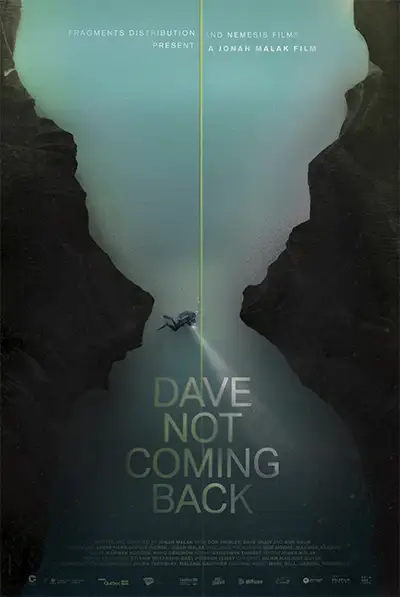
Two high-level technical cave scuba divers and long-time friends, Don and Dave, broke a world record for depth in the Boesmansgat cave in South Africa. It takes them 15 minutes to reach the bottom but 12 hours to surface. Having reached the bottom, against all odds, they find a body. They decide to come back and retrieve it. They call the parents, enroll 8 fellow divers, and hire a cameraman to document the dive. The camera will follow them throughout the preparation and the dive, including to the bottom of the cave. Little did they know that Dave would not be coming back on that historic dive. In this time of over-performance driven by self-promotion and self-filming comes Boesmansgat, a story of loss and mourning where egoism and altruism, hubris and self-control, risk-taking, and spirituality all go hand in hand. A cascade of choices and tense paradoxes lead to a tragedy long foreseen yet impossible to prevent.
The cave diving movie “Dave Not Coming Back” is available on YouTube in SD.
The Rescue (2021)
 Documentary
Documentary
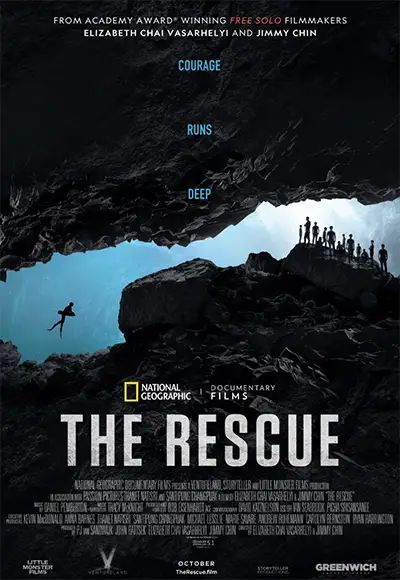
The Rescue chronicles the enthralling, against-all-odds story that transfixed the world in 2018: the daring rescue of twelve boys and their coach from deep inside a flooded cave in Northern Thailand. Using a wealth of never-before-seen material and exclusive interviews, E. Chai Vasarhelyi and Jimmy Chin keep viewers on the edge of their seats as they bring alive one of the most perilous and extraordinary rescues in modern times, shining a light on the high-risk world of cave diving, the astounding courage and compassion of the rescuers, and the shared humanity of the international community that united to save the boys.
The tension-filled story of the rescue of 12 young soccer players, ages 10-16, and their coach trapped in the Tham Luang Nag Non cave in Northern Thailand in 2018. They found themselves surrounded by water two miles from the cave entrance, facing long odds for survival. To capture the drama, the filmmakers relied on 87 hours of footage filmed by a Thai admiral’s wife, interviews with the rescue team, computer graphics, and the use of reenactments when it became too dangerous to film inside the cave.
Trained cave divers were recruited as well as Thai Navy Seals, U. S. Special Forces, Australian medical experts, a Thai nurse named “Amp” Bangngoen who helped as a translator, and thousands of volunteers to undertake the rescue in the cave’s claustrophobic, winding underground passageways.
When Seals members concluded that they did not have the diving skills required for the rescue attempt, Rick Stanton and John Volanthen, two highly experienced British divers, were called to Thailand. The inspiration of people of many backgrounds and training coming together from all over the world—including the U.S. and China—to engage in a joint undertaking captured the world’s attention.
The challenge became even more real when divers discovered four pump workers trapped not far from the cave entrance and had to undertake a dangerous rescue that became a trial run for the later attempt to free the boys. With the cave rapidly filling with water, the conditions became so daunting that one volunteer – a former Thai Navy Seal, died from a lack of oxygen.
The documentary not only depicts the bravery and determination of the divers, but offers a look into their personalities and goals, each with a compelling story. In one interview, one of the divers says that his dangerous hobby is “two parts ego, one part curiosity and one part a need to prove yourself.” The divers talk about how they had been “outsiders” all their lives, always regarded as misfits and “nerds.” Fittingly, Stanton and Volanthen first discovered the lost boys and their coach on a ledge two miles into the cave, where they had taken refuge after heavy rain submerged their route.
Thirteen Lives (2022)
 Documentary
Documentary
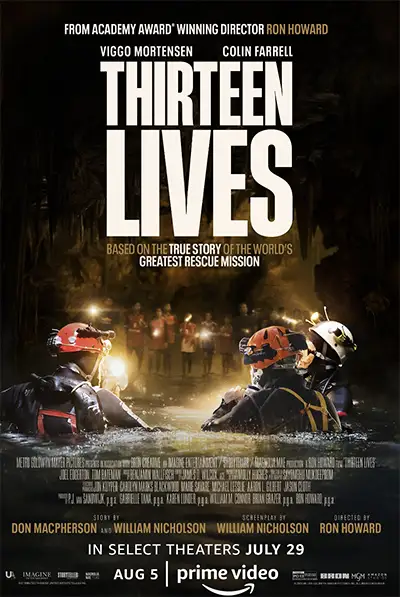
On June 23, 2018, twelve boys of the junior football team “Wild Boars” and their assistant coach, Ekkaphon Chanthawong, left practice to explore the Tham Luang cave. When the team failed to arrive at a birthday party organized by their parents, their families headed to the caves, only to find them flooded, the boys missing, and their bikes left at the entrance. The parents immediately alerted emergency services.
Royal Thai Navy SEALs, led by Captain Arnont (Teerapat Sajakul), arrive to search for the missing boys but find the dive too difficult to locate the team. Vernon Unsworth (Lewis Fitz-Gerald), a local British caver, shares his extensive knowledge of the complex and dangerous cave and suggests the authorities contact the British Cave Rescue Council.
British cavers Rick Stanton (Viggo Mortensen) and John Volanthen (Colin Farrell) travel to Thailand and attempt the dive, finding the boys and coach four kilometers from the entrance. During an attempt to deliver air tanks to the boys to keep them alive in preparation for the rescue, former Thai Navy Seal Saman Kunan (Sukollawat Kanarot) drowns. Meanwhile, as hundreds of volunteers try to mitigate poor weather conditions, a water technician from Bangkok gets local farmers’ permission to divert water from the mountain onto their fields, destroying their crops.
Realizing the boys will have to be removed through the cave via a 6-hour dive, knowing the risks are, Stanton and Volanthen contact Dr. Richard Harris (Joel Edgerton), plus supporting divers Chris Jewell (Tom Bateman) and Jason Mallinson (Paul Gleeson). With permission from the regional governor (Sahajak Boonthanakit) and minister, the divers sedate the boys and, with one diver per boy, carry each member out of the cave safely. The coach is removed last. Removed to the hospital, the parents are reunited with the team.
The end scene is the boys celebrating the birthday party that was supposed to happen on the day they entered the cave. The end credits reveal that the coach and three of the boys, who were all stateless, are given Thai citizenship. The film is dedicated to Saman Kunan, the Thai Navy Seal who died on July 6, 2018, during the rescue operation, and Beirut Pakbara, a Thai Navy Seal who later died from a blood infection.
Back
